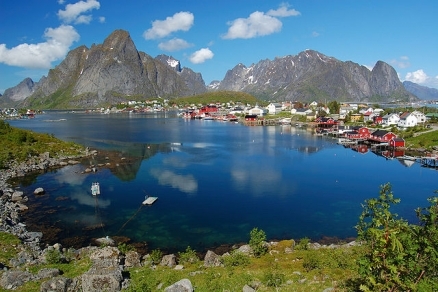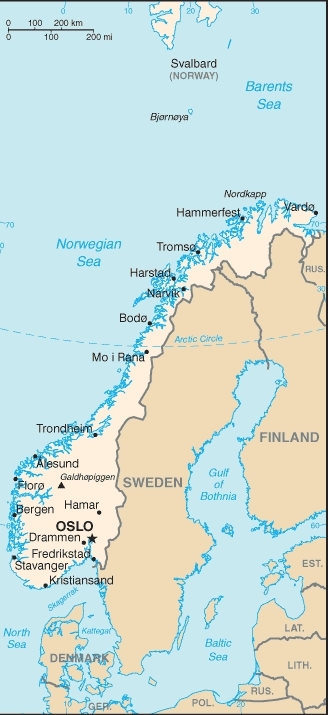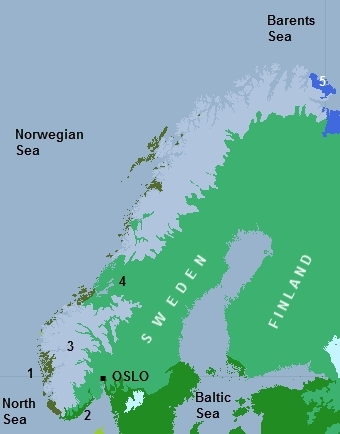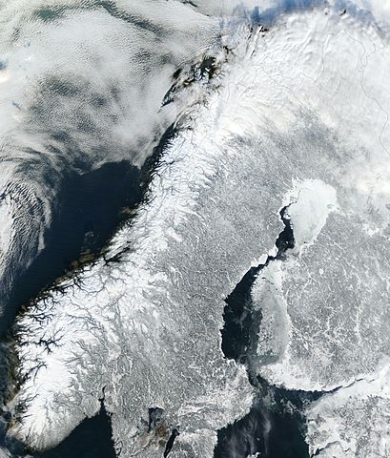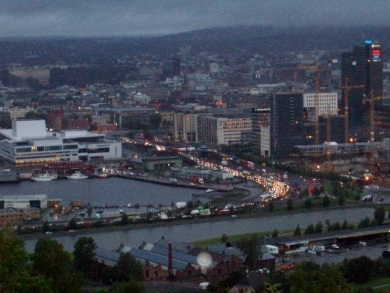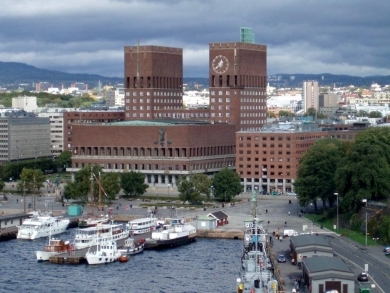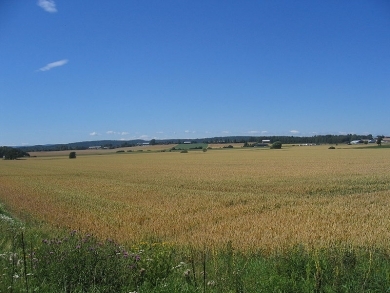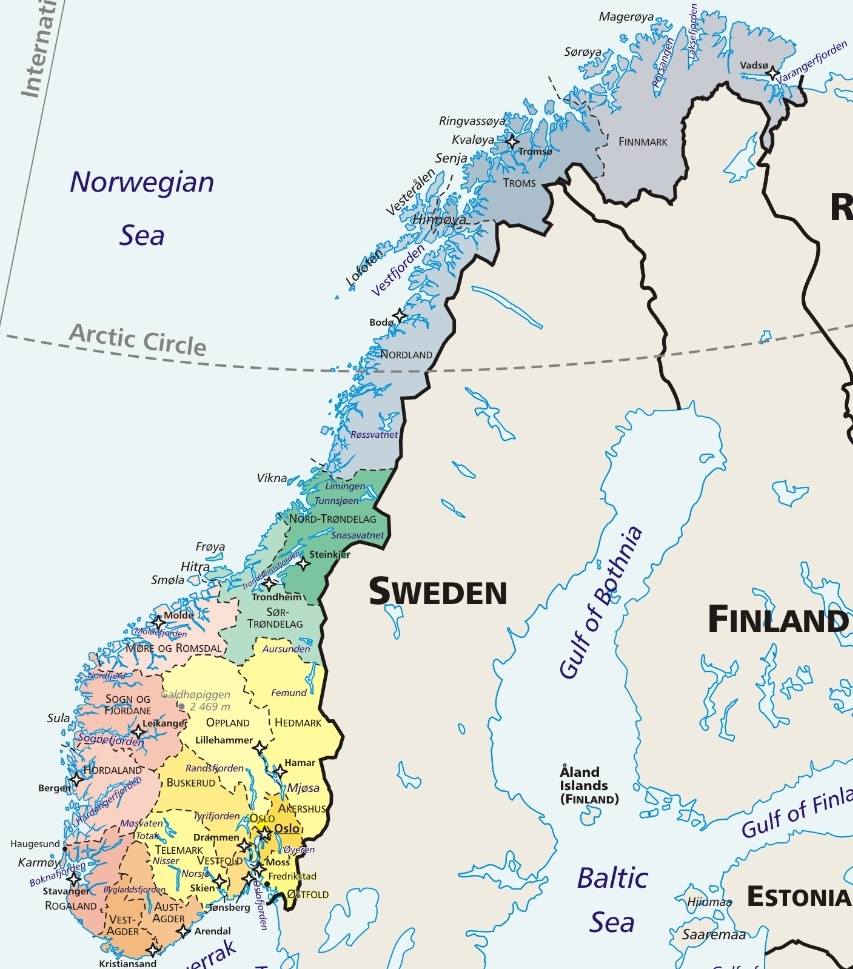Norwegian (Norway)
Contents
Norway
Countries and Regions of the World Collection  Norway is a nation of over four-and-a-half million people in northern Europe, bordering the North, Norwegian, and Barents seas, and the North Atlantic Ocean, west of Sweden.
Norway is a nation of over four-and-a-half million people in northern Europe, bordering the North, Norwegian, and Barents seas, and the North Atlantic Ocean, west of Sweden.
About two-thirds of Nrway is mountains. there are some 50,000 islands off its much-indented coastline.
Norway's landscape is highly glaciated; with mostly high plateaus and rugged mountains broken by fertile valleys and small, scattered plains. Norway has one of the most rugged and longest coastlines in the world deeply indented by fjords. The length of Norway's mainland coastline is 2,650 km. When its many long fjords, numerous small islands, and minor indentations are consider an additional 22,498 km of a coastline are added, for a total of 25,148. Separately, Norway's island coastlines are 58,133 km. In the north is arctic tundra.
Beerenberg (elev. 2,227 m) on Jan Mayen Island in the Norwegian Sea is the country's only active volcano
Its major environmental issues include:
- water pollution;
- acid rain damaging forests and adversely affecting lakes, threatening fish stocks; and,
- air pollution from vehicle emissions
The Norwegian economy is a prosperous bastion of welfare capitalism, featuring a combination of free market activity and government intervention.
The government controls key areas, such as the vital petroleum sector, through large-scale state-majority-owned enterprises.
The country is richly endowed with natural resources - petroleum, hydropower, fish, forests, and minerals - and is highly dependent on the petroleum sector, which accounts for nearly half of exports and over 30% of state revenue.
Norway is the world's second-largest gas exporter; its position as an oil exporter has slipped to ninth-largest as production has begun to decline.
Two centuries of Viking raids into Europe tapered off following the adoption of Christianity by King Olav Tryggvason in 994. Conversion of the Norwegian kingdom occurred over the next several decades.
In 1397, Norway was absorbed into a union with Denmark that lasted more than four centuries.
In 1814, Norwegians resisted the cession of their country to Sweden and adopted a new constitution. Sweden then invaded Norway but agreed to let Norway keep its constitution in return for accepting the union under a Swedish king.
Rising nationalism throughout the 19th century led to a 1905 referendum granting Norway independence.
Although Norway remained neutral in World War I, it suffered heavy losses to its shipping. Norway proclaimed its neutrality at the outset of World War II, but was nonetheless occupied for five years by Nazi Germany (1940-45).
In 1949, neutrality was abandoned and Norway became a member of NATO.
Discovery of oil and gas in adjacent waters in the late 1960s boosted Norway's economic fortunes.
In referenda held in 1972 and 1994, Norway rejected joining the European Union (EU); nonetheless, as a member of the European Economic Area, it contributes sizably to the EU budget.
Key domestic issues include immigration and integration of ethnic minorities, maintaining the country's extensive social safety net with an aging population, and preserving economic competitiveness.
Norway also asserts a territorial claim in Antarctica (Queen Maud Land and its continental shelf).
Geography
 Source: Wikimedia Commons Norway’s northern regions lie within the Arctic Circle, where there are borders with Finland and Russia, while much of the long border with Sweden runs through the Scandinavian mountains. This range, sloping to the south-east, is 1,530 km in length and has its highest areas in the south of Norway, where Galdhopiggen, Norway’s highest point, reaches a peak of 2,469 m (8,100 ft). Almost all of Norway is high ground; in the north the country becomes narrower, with mountains overlooking the fjords and the islands along the coast, and in the center and south the mountains form a high plateau, where there are permanent ice fields. The only area of low ground is around the Oslo fjord and along the coast to Stavanger. The principal rivers are the Glomma, the Lagen, and Tanaelv. Some 6% of Norway’s area is inland water--mostly long, thin lakes. Two-thirds of the country is tundra, rock, or snowfields, and one-quarter is forested, so good agricultural land is rare. Less than 3% of Norway is cultivated, and these areas are in the south-east and in the river valleys. The mountains of Norway are rich in minerals; there are deposits of iron ore, copper, titanium, coal, zinc, lead, nickel, and pyrites, and large offshore reserves of petroleum and natural gas.
Source: Wikimedia Commons Norway’s northern regions lie within the Arctic Circle, where there are borders with Finland and Russia, while much of the long border with Sweden runs through the Scandinavian mountains. This range, sloping to the south-east, is 1,530 km in length and has its highest areas in the south of Norway, where Galdhopiggen, Norway’s highest point, reaches a peak of 2,469 m (8,100 ft). Almost all of Norway is high ground; in the north the country becomes narrower, with mountains overlooking the fjords and the islands along the coast, and in the center and south the mountains form a high plateau, where there are permanent ice fields. The only area of low ground is around the Oslo fjord and along the coast to Stavanger. The principal rivers are the Glomma, the Lagen, and Tanaelv. Some 6% of Norway’s area is inland water--mostly long, thin lakes. Two-thirds of the country is tundra, rock, or snowfields, and one-quarter is forested, so good agricultural land is rare. Less than 3% of Norway is cultivated, and these areas are in the south-east and in the river valleys. The mountains of Norway are rich in minerals; there are deposits of iron ore, copper, titanium, coal, zinc, lead, nickel, and pyrites, and large offshore reserves of petroleum and natural gas.
Although Norway crosses the Arctic Circle, the climate is not as cold as might be expected, since the North Atlantic Drift brings warm, damp air to the whole country. The geographical conditions give rise to great climatic variation: it is cooler inland and to the north, where winters are long and dark with much snow, but where the sun shines day and night for part of the summer. It is wetter on the west coast, where about 2,000 mm (78.7 inches) of rain falls annually on Bergen; the mean annual rainfall in the capital, Oslo, is 730 mm, most of which falls during the summer. Temperatures in Oslo are highest in July, when the average is 17.3°C (64°F), and lowest in January, when the average falls to −4.7°C (24°F).
Location: Northern Europe, bordering the North Sea and the North Atlantic Ocean, west of Sweden
Geographic Coordinates: 62 00 N, 10 00 E
Area: 323,802 sq km (land: 304,282 sq km; water: 19,520 sq km)
Land Boundaries: 2,542 km (Finland 727 km, Sweden 1,619 km, Russia 196 km)
Coastline: 25,148 km (includes mainland 2,650 km, as well as long fjords, numerous small islands, and minor indentations 22,498 km; length of island coastlines 58,133 km)
Maritime Claims:
territorial sea: 12 nm
contiguous zone: 10 nm
exclusive economic zone: 200 nm
continental shelf: 200 nm
Denmark (Greenland) and Norway have made submissions to the Commission on the Limits of the Continental shelf (CLCS) and Russia is collecting additional data to augment its 2001 CLCS submission.
Norway and Russia signed a comprehensive maritime boundary agreement in 2010
Natural Hazards: rockslides, avalanches
Terrain: glaciated; mostly high plateaus and rugged mountains broken by fertile valleys; small, scattered plains; coastline deeply indented by fjords; arctic tundra in north. The highest point is Galdhopiggen (2,469 m).
Climate: temperate along coast, modified by North Atlantic Current; colder interior with increased precipitation and colder summers; rainy year-round on west coast
Ecology and Biodiversity
|
1. Scandinavian coastal conifer forests 3. Scandinavian montane birch forests and grasslands 4. Scandinavian and Russian taiga Map source: World Wildlife Fund See also:
Also: People and SocietyPopulation: 4,707,270 (July 2012 est.) Ethnic Norwegians speak a Germanic language. Northern Norway is also the traditional home of communities of Sami people who speak a non-Indo-European language. |
|
With a landscape largely shaped by glaciers over the last ice age, the Scandinavian Peninsula is as picturesque in the winter as it is cold. The Moderate Resolution Imaging Spectroradiometer (MODIS) instrument aboard NASA’s Terra satellite captured the above image of the Scandinavian Peninsula on February 19, 2003. Along the left side of the peninsula one can see the jagged inlets, known as fjords, lining Norway’s coast. Many of these fjords are well over 2,000 feet (610 meters) deep and were carved out by extremely heavy, thick glaciers that formed during the last ice age. The glaciers ran off the mountains and scoured troughs into Norway’s coastline with depths that reached well below sea level. When the glaciers melted, the seawater rushed into these deep troughs to form the fjords. The deepest fjord on Norway’s coast, known as Sogn Fjord, lies in southwest Norway and is 4,291 feet (1,308 m) deep. Glaciers also carved the mountains in Norway and northernmost Sweden. South of this mountainous region, however, Sweden consists mostly of flat, heavily forested land dotted with lakes. Lake Vanern and Lake Vattern, the largest of Sweden’s lakes, do not freeze completely during the winter months and can be seen clearly at the bottom of the peninsula. Lake Vattern, the smaller of the two lakes, was connected to the Baltic Sea during the last ice age. After the ice melted, a tremendous weight was lifted off of the peninsula, and the landmass rose up to separate the lake from the Baltic Sea. To the northeast of the peninsula lies Finland with more than 55,000 lakes, most of which were also created by glacial deposits. Source: NASA. Credit: Jacques Descloitres, MODIS Rapid Response Team, NASA/GSFC |
In recent years, Norway has become home to increasing numbers of immigrants, foreign workers, and asylum-seekers from various parts of the world. As of January 2011, there were 600,900 immigrants and 100,000 Norwegian-born persons with immigrant parents living in Norway. The majority of immigrants are from Poland, Sweden, Germany, and Iraq. Thirty-four percent of immigrants have Norwegian citizenship. Immigrants now make up about 12.2% of Norway’s population, but the percentage in Oslo is nearly double that.
The constitution provides for freedom of religion, and other laws and policies contribute to the generally free practice of religion in Norway. The Evangelical Lutheran Church of Norway, the state church, enjoys some benefits not available to other religious groups. Education is free through the university level and is compulsory from ages 6 to 16. At least 12 months of military service and training are required of every eligible male; approximately 40% are exempted from service for health or other reasons annually. Norway's health system includes free hospital care, physicians’ compensation, cash benefits during illness and pregnancy, and other medical and dental plans. There is a public pension system.
Norway is in the top rank of nations in the number of books printed per capita. Norway's most famous writer is the dramatist Henrik Ibsen. Artists Edvard Munch and Christian Krogh were Ibsen's contemporaries. Munch drew part of his inspiration from Europe and in turn exercised a strong influence on later European expressionists. Sculptor Gustav Vigeland has a permanent exhibition in the Vigeland Sculpture Park in Oslo. Musical development in Norway since Edvard Grieg has followed either native folk themes or, more recently, international trends.
Ethnic Groups: Norwegian 94.4% (includes Sami, about 60,000), other European 3.6%, other 2% (2007 estimate)
| A view of the city of Oslo. |
| The City Hall (Radhus) in Oslo. Although construction began in 1931, completion was delayed because of World War II. The building was finally inaugurated in 1950. The Nobel Peace Prize ceremony takes place in the City Hall every year on 10 December. |
| Lysefjorden seen from Prekestolen in the district of Ryfylke in Western Norway. |
| Landscape with grainfield in Tønsberg, southeastern Norway. Source: Karl Ragnar Gjertsen/Wikimedia Commons |
Age Structure:
0-14 years: 18% (male 431,111/female 412,864)
15-64 years: 66% (male 1,568,729/female 1,529,799)
65 years and over: 16% (male 326,711/female 422,635) (2011 est.)
Population Growth Rate: 0.327% (2012 est.)
Birthrate: 10.8 births/1,000 population (2012 est.)
Death Rate: 9.22 deaths/1,000 population (July 2012 est.)
Net Migration Rate: 1.69 migrant(s)/1,000 population (2012 est.)
Life Expectancy at Birth: 80.32 years
male: 77.65 years
female: 83.14 years (2012 est.)
Total Fertility Rate: 1.77 children born/woman (2012 est.)
Languages: Bokmal Norwegian (official), Nynorsk Norwegian (official), small Sami- and Finnish-speaking minorities. Note: Sami is official in six municipalities.
Literacy (age 15 and over can read and write): 100%
Urbanization: 79% of total population (2010) growing at an annual rate of change of 1.2% (2010-15 est.)
History
The Viking period (9th to 11th centuries) was one of national unification and expansion. The unification of Viking settlements along the Norwegian coast was well advanced by the time of St. Olav’s death in 1030. He is credited with overseeing the population’s conversion to Christianity. A period of civil war ended in the 13th century when Norway expanded its control overseas to parts of the British Isles, Iceland, and Greenland. Norwegian territorial power peaked in 1265, and the following year the Isle of Man and the Hebrides were ceded to Scotland. Competition from the Hanseatic League and the spread of the Black Death weakened the country. The Norwegian royal line died out in 1387, as the country underwent a period of union with Denmark under King Olaf; union with Sweden followed in 1397. Attempts to keep all three countries united failed, with Sweden finally breaking away in 1521. By 1586, Norway had become part of the Danish Kingdom. In 1814, as a result of the Napoleonic wars, Norway was separated from Denmark and combined with Sweden again.
The Napoleonic War saw Denmark side with France in 1807, following the British attack on Copenhagen. With Sweden joining the coalition against Napoleon in 1813, the Treaty of Kiel in 1814 transferred Norway to the Swedish King following Denmark’s defeat. The Norwegians ignored this international agreement and chose the Danish Prince as their king and adopted the liberal Eidsvoll Constitution on May 17, 1814 (May 17 later became Norway’s national holiday). After a few months a Swedish-Norwegian union was agreed under the Swedish crown, with Norway being granted its own parliament (Storting) and government. However, the Swedish King attempted unsuccessfully to revise this constitution in the 1820s and 1830s and parliamentary control over the executive was only obtained following a struggle during the 1870s and 1880s. Norwegian nationalism was associated with the creation of a national standard for written Norwegian based on dialects, rather than the Danish-based official language. There were numerous disputes between the Norwegian Government and Sweden, notably over requests for a Norwegian consular service to reflect the importance of Norway’s expanding merchant fleet. In 1905 the union between the two countries was dissolved following two plebiscites in Norway, one opting for independence and one for a constitutional monarchy. Danish Prince Carl was unanimously elected as King by the Storting in 1905 and took the name of Haakon VII (after the kings of independent Norway) on his arrival in Norway. Haakon died in 1957 and was succeeded by his son, Olav V, who died in January 1991. Upon Olav's death, his son Harald was crowned as King Harald V.
Norway was a nonbelligerent during World War I, but as a result of the German invasion and occupation during World War II, Norwegians generally became skeptical of the concept of neutrality and turned instead to collective security. During the period of Nazi German occupation, over 742 of Norway’s Jews were killed. More than 900 Jews survived mass deportation by hiding and escaping, many of them by crossing the border into Sweden. Norway was one of the signers of the North Atlantic Treaty in 1949 and was a founding member of the United Nations. The first UN Secretary General, Trygve Lie, was a Norwegian. Under the terms of the will of Alfred Nobel, the Storting (parliament) elects the five members of the Norwegian Nobel Committee who award the Nobel Peace Prize each year on December 10 to those who have “done the most or best work for fraternity between nations, the abolition or reduction of standing armies and for the holding and promotion of peace congresses.” Norway held referenda on seeking entry into the European Union (EU) and its predecessor the European Community in 1972 and 1994, with the population rejecting membership both times. Today, a majority remains opposed to EU membership.
Government
Government Type: Constitutional monarchy
The functions of the king are mainly ceremonial, but he has influence as the symbol of national unity. Although the 1814 constitution grants important executive powers to the king, these are almost always exercised by the Council of Ministers in the name of the king (King's Council). The Council of Ministers consists of a prime minister--chosen by the political parties represented in the Storting--and other ministers.
The 169 members of the Storting are elected from 19 fylker (counties) for 4-year terms according to a complex system of proportional representation.
Capital: Oslo - 875,000 (2009)
Administrative divisions: 19 counties (fylker, singular - fylke); Akershus, Aust-Agder, Buskerud, Finnmark, Hedmark, Hordaland, More og Romsdal, Nordland, Nord-Trondelag, Oppland, Oslo, Ostfold, Rogaland, Sogn og Fjordane, Sor-Trondelag, Telemark, Troms, Vest-Agder, Vestfold (see map below).
Each fylke (county) is headed by a governor appointed by the king in council, with one governor exercising authority in both Oslo and the adjacent county of Akershus.
Dependent Areas: Bouvet Island, Jan Mayen, Svalbard
Independence Date: 7 June 1905 (Norway declared the union with Sweden dissolved); 26 October 1905 (Sweden agreed to the repeal of the union)
Legal System: mixed legal system of civil, common, and customary law; Supreme Court can advise on legislative acts. Norway accepts compulsory International Court of Justice (ICJ) jurisdiction with reservations; and accepts International criminal court (ICCt) jurisdiction. The special High Court of the Realm hears impeachment cases; the regular courts include the Supreme Court (18 permanent judges and a Chief Justice), courts of appeal, city and county courts, the labor court, and conciliation councils. Judges attached to regular courts are appointed by the king in council after nomination by the Ministry of Justice.
Politics: Until the 1981 election, Norway had been governed by majority Labor Party governments since 1935, except for three periods (1963, 1965-71, and 1972-73). The Labor Party lost its majority in the Storting in the 1981 elections.
From 1981 to 2005, governments alternated between Labor minority governments and Conservative-led coalition governments. In the run-up to the 2005 election, Labor Party leader Jens Stoltenberg reached out to the Socialist Left (SV) party and agrarian Center party to form a “Red-Green” coalition government that commanded a majority of seats in parliament. Stoltenberg’s government was the first majority government in Norway in over 20 years, but the governing coalition has had to bridge substantial policy differences to build this majority. The 2005 election was historic because it was the first time the Labor Party was in a coalition government since the 1940s, the first time SV was ever in the national government, and the first time the Center Party joined with the socialist parties as opposed to the right-of-center parties. On September 14, 2009, the “Red-Green” coalition won reelection for 4 more years after winning 86 of the 169 seats in parliament.
The Stoltenberg-led coalition government that took office in October 2005 and was reelected in 2009 continued the northern policy laid down by the government led by Kjell Magne Bondevik (of the Christian Democratic Party) in 2003. This "High North" strategy has remained one of the constant themes of this government and encompasses many of the government’s highest priorities, including environmental protection, responsible development of energy resources, maintaining a security presence in the Arctic, and developing Norway’s relations with Russia. In 2010, Norway concluded bilateral agreements with Russia resolving the two countries’ long-disputed maritime boundary in the Barents Sea and Arctic Ocean and facilitating travel for border residents. Upon ratification, the maritime boundary agreement entered into force in 2011.
International Environmental Agreements
Norway is party to international agreements on: Air Pollution, Air Pollution-Nitrogen Oxides, Air Pollution-Persistent Organic Pollutants, Air Pollution-Sulfur 85, Air Pollution-Sulfur 94, Air Pollution-Volatile Organic Compounds, Antarctic-Environmental Protocol, Antarctic-Marine Living Resources, Antarctic Seals, Antarctic Treaty, Biodiversity, Climate Change, Climate Change-Kyoto Protocol, Desertification, Endangered Species, Environmental Modification, Hazardous Wastes, Law of the Sea, Marine Dumping, Ozone Layer Protection, Ship Pollution, Tropical Timber 83, Tropical Timber 94, Wetlands, and Whaling.
Water
Total Renewable Water Resources: 381.4 cu km (2005)
Freshwater Withdrawal: 2.4 cu km/yr (23% domestic, 67% industrial, 10% agricultural)
Per Capita Freshwater Withdrawal: 519 cu m/yr (1996)
Agriculture
Agricultural products: barley, wheat, potatoes; pork, beef, veal, milk; fish
Irrigated Land: 1,180 sq km (2008)
Resources
Natural Resources: petroleum, natural gas, iron ore, copper, lead, zinc, titanium, pyrites, nickel, fish, timber, hydropower
Land Use:
arable land: 2.7%
permanent crops: 0%
other: 97.3% (2005)
Economy
Norway is one of the world's richest countries in per capita terms. It has an important stake in promoting a liberal environment for foreign trade. Its large shipping fleet is one of the most modern among maritime nations. Metals, pulp and paper products, chemicals, shipbuilding, and fishing are the most significant traditional industries.
Norway's emergence as a major oil and gas producer in the mid-1970s transformed the economy. Large sums of investment capital poured into the offshore oil sector, leading to greater increases in Norwegian production costs and wages than in the rest of Western Europe up to the time of the global recovery of the mid-1980s. The influx of oil revenue also permitted Norway to expand an already extensive social welfare system. Norway established a petroleum fund (the Government Pension Fund Global) to save and invest the state’s oil and gas earnings. The fund was valued at over 3 trillion kroner (over $500 billion) at the end of 2011. Thanks in part to prudent financial regulation and to high prices in world markets for its energy and fisheries exports, the global financial crisis has had only a limited impact on Norway. Norway’s unemployment rate stood at 3.4% at the end of November 2011. In recent years, labor costs have increased faster than in its major trading partners, eroding industrial competitiveness. Though the impact of international economic turmoil is uncertain, Norway is expected to experience moderate growth in 2012.
Norway twice voted against joining the European Union, but, with the exception of the agricultural and fisheries sectors, Norway enjoys free trade with the EU under the framework of the European Economic Area. This agreement aims to apply the four freedoms of the EU's internal market (goods, persons, services, and capital) to Norway. As a result, Norway normally adopts and implements most EU directives. Norwegian monetary policy is aimed at maintaining a stable exchange rate for the krone against European currencies, of which the euro is a key operating parameter. Norway does not have a fixed exchange rate. Its principal trading partners are the EU, the United States, and China.
Energy Resources
Offshore hydrocarbon deposits were discovered in the 1960s, and development began in the 1970s. Production increased significantly in the 1990s as new fields came on stream. The growth of the petroleum sector has contributed significantly to Norwegian economic vitality. Current petroleum production capacity is approximately 2.6 million barrels per day. Production in gas has increased rapidly during the past several years as new fields are opened, with crude oil production in decline. Hydropower provides nearly all of Norway's electricity, and all of the gas and most of the oil produced is exported. The Norwegian continental shelf's total recoverable petroleum resources have been estimated at 12.8 billion standard cubic meters of oil equivalent (scm o.e.), of which 5.5 billion have been recovered.
Norway is the world's seventh-largest oil exporter and second-largest gas exporter (2010). Norway provides much of Western Europe's crude oil and gas requirements. In 2010, Norwegian oil and gas exports accounted for approximately 47% of total exports. In addition, offshore exploration and production have stimulated onshore economic activities. In 2010, 26% of state revenues were generated from the petroleum industry; taxes and direct ownership ensure high revenues. Foreign companies, including many American ones, participate actively in the petroleum sector. The oil industry directly employs roughly 40,000 people in core extraction activities. Over 250,000 are employed in petroleum-related activities.
Petroleum production peaked in the early 2000s, and the pace of discoveries has not been sufficient to reverse that trend. However, innovative use of extraction technologies has extended the lives of fields and major oil and gas discoveries were made on the Norwegian continental shelf in 2011. Declines in petroleum extraction is to some degree offset by increased extraction of natural gas in both new and existing fields, such as Snohvit and Troll. Given the energy industry’s weight in the economy, diversification into other industries is a long-term challenge for Norway.
In anticipation of eventual declines in oil and gas production, Norway saves state revenue from the petroleum sector in the world's second largest sovereign wealth fund, valued at over $500 billion in 2010.
After solid GDP growth in 2004-07, the economy slowed in 2008, and contracted in 2009, before returning to positive growth in 2010-11, however, the government budget is set to remain in surplus.
GDP: (Purchasing Power Parity): $264.5 billion (2011 est.)
GDP: (Official Exchange Rate): $479.3 billion (2011 est.)
GDP- per capita (PPP): $53,300 (2011 est.)
GDP- composition by sector:
agriculture: 2.7%
industry: 38.3%
services: 59% (2011 est.)
Industries: petroleum and gas, food processing, shipbuilding, pulp and paper products, metals, chemicals, timber, mining, textiles, fishing
Currency: Norwegian kroner (NOK)
